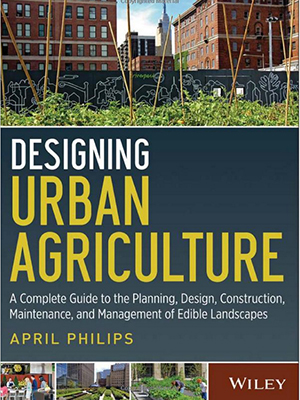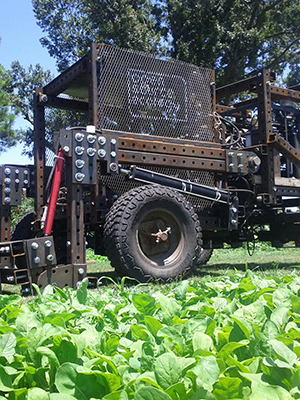
Landscape architect April Philips , FASLA, prefaces her new book, Designing Urban Agriculture: A Complete Guide to the Planning, Design, Construction, Maintenance, and Management of Edible Landscapes , by writing, “because the food system in America is broken, the health of our cities and communities are at risk.” Indeed, access to healthy food is severely limited in many urban neighborhoods, while industrial agriculture is itself a massively-polluting enterprise. By situating food systems as “part of a city’s urban systems network,” Philips frames food as a design issue instead of simply a horticultural concern. With Designing Urban Agriculture, Philips sets out to explain not only how to design urban-scale agricultural landscapes, but also how designers can collaborate with communities to change urban food systems.
Designing Urban Agriculture is an exhaustive textbook on food and urban design. Topics such as food justice, systems thinking, public health, ecological agriculture, public policy, and construction methods are supported by numerous illustrated case studies. For instance, the Lafayette Greens project in Detroit, Michigan, which recently won an ASLA professional award , shows how edible landscapes can be agents of transformation. Designed by Kenneth Weikal Landscape Architecture , this three-quarter-acre landscape replaces a recently demolished building, beautifying what would otherwise be a vacant lot. Over 200 species of edible plants are grown on the site, which functions not only as a farm, but also as a recreational space for office workers and downtown residents. In this way, Lafayette Greens serves as a catalyst for the continuing transformation of downtown Detroit. The site’s design makes extensive use of repurposed and salvaged materials, continuing this theme of regeneration.

While urban agriculture has been successful at a local scale, it has yet to economically challenge existing industrial food systems. However, efforts to increase the scale and economic viability of urban farming are underway. Big City Farms in Baltimore is a for-profit agricultural operation that aims to establish a network of farms on vacant land across the city. Big City Farms’ pilot project entails six 3,000 square-foot plastic hoop greenhouses built on top of a contaminated brownfield site. Because of this contamination, all plants are grown on top of the preexisting site using imported soil. In addition to profitability, Big City Farms’ goals include the generation of green jobs and the distribution of organic food to local consumers.

Philips stresses that the success of urban farming depends on integrating ecological, economic, and cultural systems. She writes, “with urban agricultural landscapes, the ultimate sustainability goal is to design systems that allow for accommodating a dynamic of interdependence.” For example, Our School at Blair Grocery , an urban farm and educational facility in the Lower Ninth Ward of New Orleans, responds to the neighborhood’s nutritional, economic, and social needs stemming from the devastation of Hurricane Katrina. The operation educates neighborhood youth in both agricultural and business practices – students not only grow food on the site, but also sell it to markets across the city, gaining valuable skills in the process.

The above examples barely scratch the surface of Designing Urban Agriculture. This is a textbook filled with tons of details. It could be the foundational text of a semester-long course in a landscape architecture school. Certainly, it should be required reading for any landscape architecture student interested in urban farming.
This guest post is by Ben Wellington , Master’s of Landscape architecture graduate, Louisiana State University and ASLA 2012 summer intern.
Image credits: (1) Wiley, (2) ASLA 2012 Professional General Design Award Winner. Lafayette Greens. Keith Weikal Landscape Architecture / image credit: Beth Hagenbuch, (3) Big City Farm / The Baltimore Sun, (4) School at Blair Grocery / School at Blair Grocery blog
Aucun commentaire:
Enregistrer un commentaire